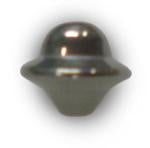If you have purchased a bead mill homogenizer, you might have seen a chart which shows what bead material and size should be used for a variety of different samples. In practice, proper bead selection is more multi-factorial than can be effectively expressed with a chart that considers the type of sample being processed.

A selection of beads from Benchmark Scientific, including silica (white), zirconia (brown), and stainless steel.
Homogenizer Bead Selection:
When selecting a bead to use for your homogenization, there are a number of factors you should consider:
- Size of the sample / "particle size". For our purposes, a "particle" is any solid mass - could be a chunk of a mineral or a piece of tissue. The larger the particle size the more momentum will be necessary in order to break through it. That requires larger and / or denser beads.
- Toughness of the sample material. The tougher the tissue, the more momentum will be required to penetrate it. Therefore, you'll need larger and / or denser beads for tougher samples.
- Desired particle size. While large beads are better at disrupting tissue, smaller beads, which are usually present in far greater numbers than large beads, create many more collisions and will break down particles to smaller sizes. Small beads are preferred if you want to more efficiently lyse cells and organelles, for instance. The opposite would be true if you wanted to keep organelles intact, or if you wanted to recover some viable cells. Just keep in mind that small beads won't do you any good if they can't disrupt the gross structure of the particles. In situations involving large, tough samples where small particles sizes are desired, you may get the best results from a mixture of large and small beads.
- Elasticity of the sample material. Highly elastic or rubbery samples are often not efficiently homogenized by round beads even if they are large and dense, as the beads will simply bounce off. Instead, elastic samples may require cutting more than bashing. Beads which are edged or irregularly shaped, or a sharp material such as garnet are more appropriate.
- Application / analyte. Not all bead materials are suitable for all applications. For instance, DNA sticks to glass and therefore glass beads should be avoided when DNA extraction is required. If you are processing RNA, you may want to use beads which have been pre-treated to be RNase-free. You should also ensure that the bead material is compatible with any reagents used in the homogenization mixture.
- The size of the tube / vessel. This often isn't a concern, but it is possible to use beads which are too large for the tube that you are homogenizing in. If a bead doesn't look like it has plenty of room to shake around, it's probably too large. For standard 1.5 / 2.0 ml microtube-sized tubes, that usually means you should keep the bead size under 4 mm, but there are some special exceptions, such as using one large bead with smaller sharp particles to break up elastic tissue.

A Stainless Steel "UFO" Bead from Next Advance.
Homogenizer Bead FAQ:
Can I re-use beads?
It depends on the bead material. Beads which are prone to cracking or breaking down, such as garnet shards or glass, should not be reused or reused once at most. Harder beads, such as zirconium or steel, can be reused. In most instances, however, collecting, washing, sterilizing, and reusing beads isn't worth the time and effort. Beads in bulk are usually very inexpensive.
Do NOT re-use tubes, however. Over time, tubes may become structually compromised due to the many high-speed impacts of the beads inside the tube. Nothing is worse than having a tube explode inside your homogenizer.
Can I use beads from a different manufacturer in my homogenizer?
Absolutely. The homogenizer doesn't know what beads are being used. You're welcome to use beads from any manufacturer in any homogenizer, so long as they are suitable for the vessel you are homogenizing in.
Can I use pre-filled bead kits from a different manufacturer in my homogenizer?
Sometimes. Many bead mills use special or proprietary tubes. For instance, Bullet Blenders are only designed to work with specific kinds of tubes, and using a different tube may result in breakage or poor homogenization. Some high-powered bead mills, such as the Precellys Evolution, have special reinforced tubes which are designed to withstand the impact of the beads. Others, such as the BeadBug, advertise that their kits are cross-compatible with other devices. Generally the differences in price of the kits isn't huge so we recommend sticking with the manufacturer of your homogenizer. If you do try other kits, do a dry run to ensure there isn't any issue with the tubes before adding a sample to them.
TRIzol / TRI reagent becomes discolored when exposed to stainess steel beads for extended periods of time. Is this okay? Will it affect my RNA quality?
From what we can tell, the consensus is that the discoloration of TRIzol / TRI reagent is only discoloration; it does not affect the reagent's performance nor does it affect RNA quality.

Bead ProTip:
With the exception of instances of chemical compatibility, there is almost never any detriment to using a denser bead. A dense material, such as stainless steel or chrome steel, is always a great fallback. Also, if you don't want to keep a lot of different types of beads on hand, keeping a few sizes of dense beads is a good way to reduce the number of different beads or bead kits you have in your lab.
